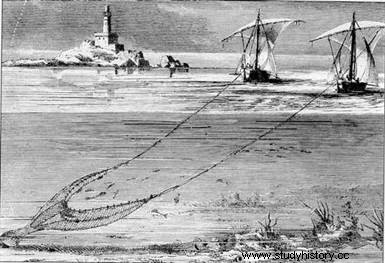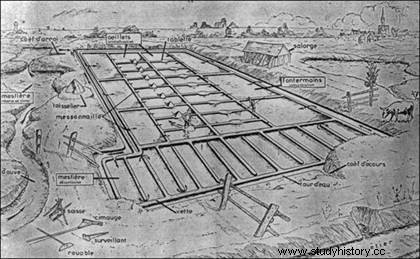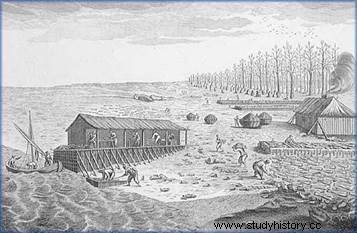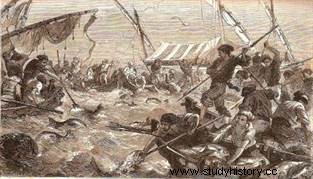 In modern times, from the late 15th to the late 18th century, the fishing activity represents a fundamental challenge for coastal populations. It may be, as with shore fishing, self-sustaining through a gathering economy. But it is also a question, through larger fisheries, of earning money, and building up significant capital which can then be reinvested in other activities, as is the case for the Saint-Malo with the race. In this, in modern times, fishing is a good way for coastal populations to preserve their status, even to develop and enrich themselves.
In modern times, from the late 15th to the late 18th century, the fishing activity represents a fundamental challenge for coastal populations. It may be, as with shore fishing, self-sustaining through a gathering economy. But it is also a question, through larger fisheries, of earning money, and building up significant capital which can then be reinvested in other activities, as is the case for the Saint-Malo with the race. In this, in modern times, fishing is a good way for coastal populations to preserve their status, even to develop and enrich themselves.
From gathering to fishing
The first step is to analyze the activity of gathering, which prevailed in coastal societies in modern times. The picking of "seafood" was common among coastal populations. This term was used by the Europeans to qualify and define these fish resources, immediately available on the shore. It was, for example, a gathering of seaweed, goëmon, that the sea rejected, or that we were going to cut on the coast, whether in the Atlantic, on the coasts of the Channel, or in the Mediterranean. . But other natural products were also collected, such as pebbles, sand, or pieces of rock fallen after storms and heavy seas. Nevertheless, in modern times, and especially from the 18th century, the authorities were trying to curb these practices, so that the coastline would not erode too quickly. For example, the beach of Pampelonne, near Saint-Tropez, has long been a reservoir of sand used for construction along the entire coast of the Côte d'Azur; today it is a place very popular with tourists, and therefore safeguarded.
“Seafood” was also highly sought after by small-scale shore fishermen, who strolled along the coasts to collect various products. These are shellfish, oysters, mussels, cockles, etc. This collection was organized mainly in areas with tides, and in particular in the waters of the Atlantic Ocean, the English Channel, or the North Sea. When the tide clears the space known as the "foreshore", the collectors then come to the area, and devote themselves to their practices. For example, it can also be the collection of natural sponges, fished in Sardinia, Sicily, Tunisia and Greek waters. Another fishing, sometimes practiced by the same very lucrative, existed at that time:coral fishing. Coral was highly sought after in the Mediterranean, but also beyond:it was used in particular in small quantities in the pharmacopoeia, and it was also used for goldsmithing and jewellery. Coral – especially red – was offered, in modern times, to renowned visitors:when Marie de Medici came to Marseilles to marry King Henri , the locals who welcomed him offered him a branch of coral as a welcome, for example.
 Of all the fish resources that we have just exposed, the most important is salt. It is fundamental, both for the metabolism and for the preservation of food. Sea salt is obtained using similar devices in the Atlantic or the Mediterranean:small dykes are erected and "traps" are created, where the water is trapped, and where it ends up evaporating, revealing the presence of salt. These devices existed in France, and in particular in Hyères, in the peninsula of Giens, as well as in Guérande or Bourgneuf. But they were also present throughout Europe, in Venice and Setubal in particular.
Of all the fish resources that we have just exposed, the most important is salt. It is fundamental, both for the metabolism and for the preservation of food. Sea salt is obtained using similar devices in the Atlantic or the Mediterranean:small dykes are erected and "traps" are created, where the water is trapped, and where it ends up evaporating, revealing the presence of salt. These devices existed in France, and in particular in Hyères, in the peninsula of Giens, as well as in Guérande or Bourgneuf. But they were also present throughout Europe, in Venice and Setubal in particular.
The salt marshes were mainly exploited, until the end of the Middle Ages, by monastic establishments and lords. Then, from the 14th century, the State replaced the lords and ecclesiastical institutions, and organized the exploitation of the salt marshes for its own benefit. The State in France tried to control this production:in the 14th century, during the Hundred Years War , we established a taxation weighing on salt, known to almost everyone, the "gabelle".
"Fishing on the shore", in all the cases we have just mentioned, is omnipresent. It is a fishing on foot, where one goes, at low tide, with bare hands or with a landing net, to collect what the sea has left, and in particular shells, crustaceans, or small fish. It can also be a small coastal fishery, practiced without going far from the coast, with fishing vessels. We leave the fishing port in the morning and return in the evening, most often before dark. However, this coastal fishing was practiced later in the Ponant regions than in the Mediterranean. Until the 15th century, in the Ponant areas (Gascony, Normandy, Brittany, Flanders), people did not want to go too far, for fear of reaching the "kingdom of the dead". This is the context of the "repulsion" of the sea, described by the historian Alain Corbin in his work The Sea. Terror and Fascination.
Offshore fishing and deep-sea fishing
Offshore fishing is practiced by going away from the shore for several days. In the Mediterranean, this is, for example, fishing for bluefin tuna, carried out using nets. In northwestern Europe, it is above all a matter of herring fishing, of which the Dutch have made a specialty in modern times, even becoming, according to the historian Alain Cabantous , a veritable “herring civilisation”. Nevertheless, in the 17th century, we witnessed a drop in prices, which meant that herring became a symbolic fish for popular consumption. It will also see its conservation improved:you can clean it, empty it and "put it in a crate" on the boat, you can smoke it, or place it in jars with a mixture of water and white vinegar.
Currently, herring is still widely caught and consumed in this part of Europe; it is found symbolically in certain popular festivals, such as on the occasion of the carnivals of maritime Flanders, in Dunkirk, Douai, Dieppe, Calais, or Boulogne-sur-Mer. Offshore fishing, mainly carried out towards Newfoundland, and set up in France by the people of Saint-Malo, is the most prestigious fishery. It can be the source of immense fortunes, as has been observed among Malouin fishermen. The fortunes made by the Malouins through cod fishing will be largely invested in racing operations. Among these corsairs, some will reinvest the money earned "at cod" to arm boats in the race, capture galleons, and thus make a fortune.
 It is therefore, in the context of offshore fishing, as we suspect, to away for several weeks from its home port, and to practice its activity in the waters of the high seas. to circumvent the American continent by the North. In this fishing area, the most popular fish is cod. It was the Norwegians, the fishermen of Bergen, who were the first to go fishing for these fish, much larger than the herring loved by the Dutch.
It is therefore, in the context of offshore fishing, as we suspect, to away for several weeks from its home port, and to practice its activity in the waters of the high seas. to circumvent the American continent by the North. In this fishing area, the most popular fish is cod. It was the Norwegians, the fishermen of Bergen, who were the first to go fishing for these fish, much larger than the herring loved by the Dutch.
Very quickly, these Scandinavians were imitated by other European cod fishers, especially the English and the French. Newfoundland will therefore find itself at the heart of a political issue, at the heart of international relations between European states:during the signing of the Treaty of Utrecht in 1713 , at the end of the War of the Spanish Succession , France had to abandon a large part of Newfoundland to the English. France retained a few islets, a few bases (Saint-Pierre-et-Miquelon in particular), which enabled it to continue to practice deep-sea fishing.
The cod that is caught and that is consumed by Europeans happens to be packaged in two ways, in two ways. At first, it is a salted and dried cod on land, which is called “stockfish” or “baccalau”. But it can also be cod packaged on board the boat:soaked in brine, in a composition heavily loaded with salt, it remains flexible. This is the "green cod", which requires less working time to be disgorged, but which, in return, keeps much shorter than salted and dried cod on land. All these techniques used in deep-sea fishing lead us to question the methods used by fishermen to optimize their yields.
Exploitation techniques
Initially it involves fishing with lines and nets. These are the simplest techniques. The landing net, for example, is considered a type of net. The line, between a rod and a hook, is also one. The first major technique used was "longline fishing", widely used in the Mediterranean world in modern times:a line is dropped to the bottom of the sea which itself has other smaller lines equipped with hooks. In a way, we multiply the lines in order to be able to catch more fish. The Catalans, for their part, perfected this technique by equipping the lines with floats, which thus became more visible and more manageable. This is the “pendi longline” technique.
The Catalans would have introduced this technique in Provence and would have caused conflicts over almost a century. By introducing this way of fishing in Provence, the local fishermen would have risen up against the Catalans, the excessive catches depleting the seabed. Victim of its success, in a way, longline fishing was gradually doomed… but not abandoned. Fishermen, in Provence in particular, also used traps, traps, baskets, with bait inside, in order to catch fish more easily. Another technique, widely used in modern times, concerns the use of nets. In Provence, the technique most used was that of "fishing with beef":two tartanes, that is to say two small boats, move at the same speed, each holding a rope and pulling a pocket.
The use of these nets represents a technique that seems to have been introduced in southern Europe by the Catalans around 1720 -1730 . They were probably Catalans fleeing Catalonia, where this fishing was prohibited under penalty of death, because considered harmful to the seabed, since the nets scraped the bottom of the sea and destroyed the fauna. These nets, also called "essaugues", were very expensive:it was estimated, in modern times, that the price of the net was almost equal to the price of the boat. Ownership of the net even happened to be divided into shares, into “quirats”. This is how historians, nowadays, in wills or inventories after death, for example, can find traces of these shares of nets left to the heirs.
 In addition to nets and lines, fishermen in modern times created and implemented systems of "fixed fisheries". In fact, three types can be distinguished. The first technique consists in the creation of “parks”, oyster farming (for oysters) or mussel farming (for mussels). These are coastal farms, on the model of what can then be found on land in the context of agriculture. The second type of "fixed fishery" is the "bordigue":these are "traps", created from reeds, for example, where the fish slips and is trapped.
In addition to nets and lines, fishermen in modern times created and implemented systems of "fixed fisheries". In fact, three types can be distinguished. The first technique consists in the creation of “parks”, oyster farming (for oysters) or mussel farming (for mussels). These are coastal farms, on the model of what can then be found on land in the context of agriculture. The second type of "fixed fishery" is the "bordigue":these are "traps", created from reeds, for example, where the fish slips and is trapped.
In reality, when the fish enter the weir, systems are introduced with reeds to take the fish to traps, where they are caught. Finally, the third and last type of “fixed fishery” is the trap, extremely famous in the Mediterranean basin, and particularly in Provence. Traps are fishing devices that are very expensive, complex, and have been used since antiquity in the Mediterranean. In this, they are by no means new in modern times...but are still widely used. More precisely, it is a system of fixed nets used to catch tuna, a maze of meshes, on the model of the bordigues:the trap is "wedged" by a group of fishermen from the beginning of spring . Traps, like ships, are divided into quirats, parts.
Bibliography
- CORBIN Alain, The Sea. Terror and Fascination, Paris, Seuil, Coll. History Points, 2011.
- CORBIN Alain, The territory of the void. The West and the desire for the shore, 1750-1840, Paris, Flammarion, Coll. Flammarion fields, 1990.
- CABANTOUS Alain, LESPAGNOL André, PÉRON Françoise, The French, the land and the sea (XIIIᵉ - XXᵉ centuries), Paris, Fayard, 2005.
